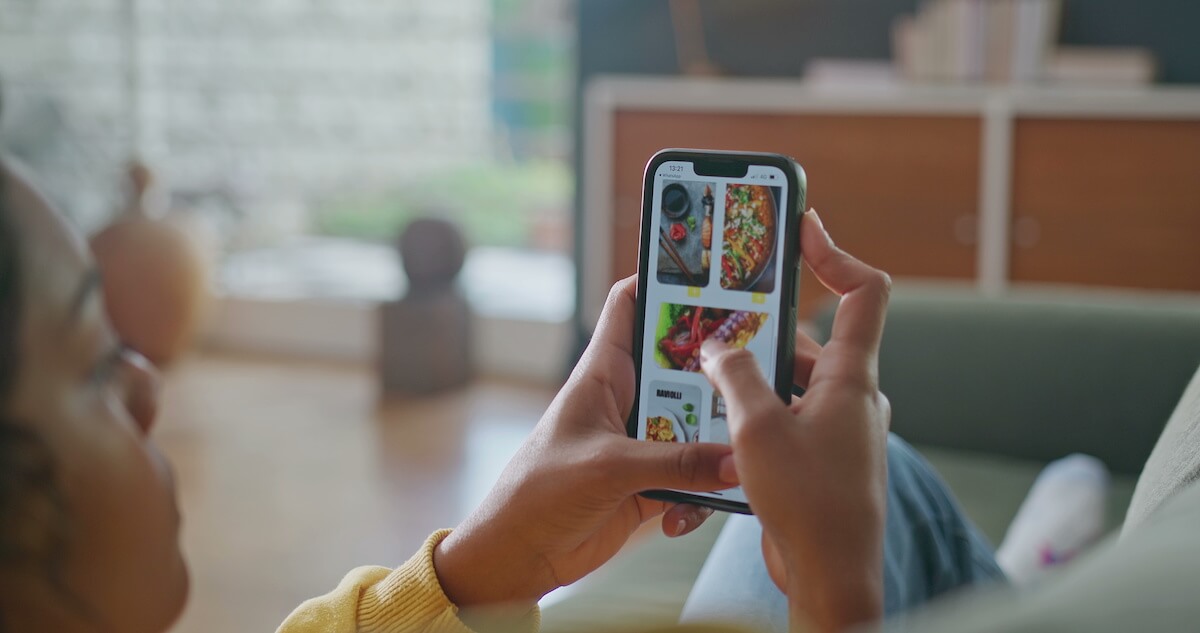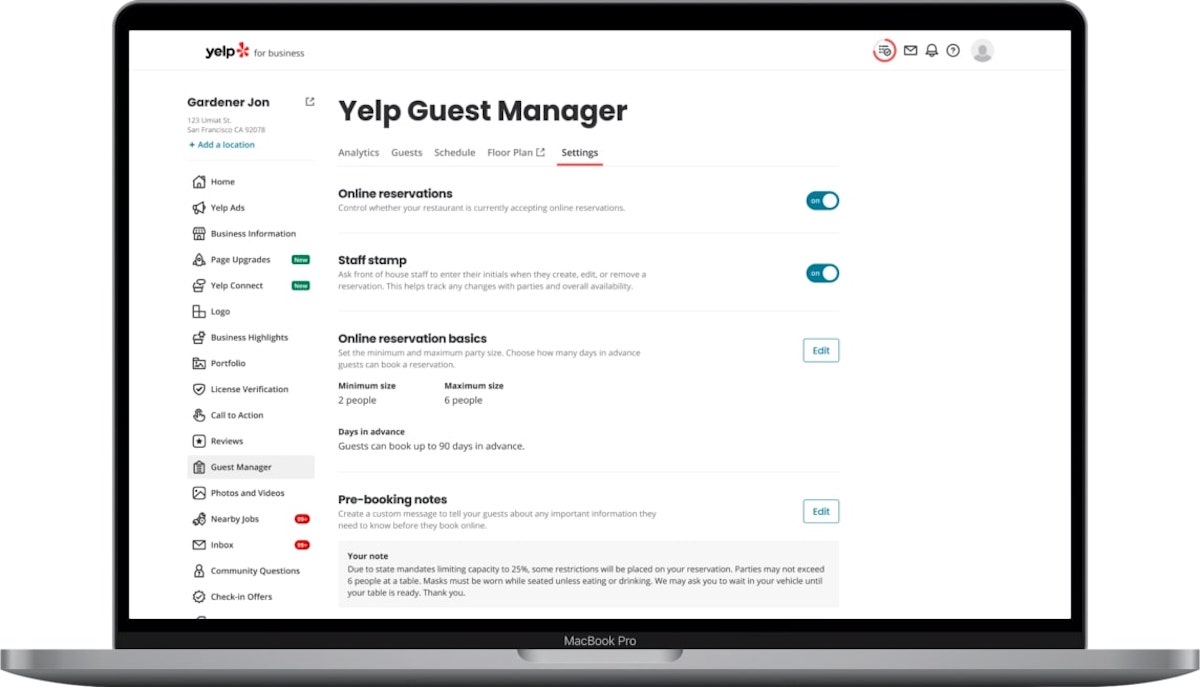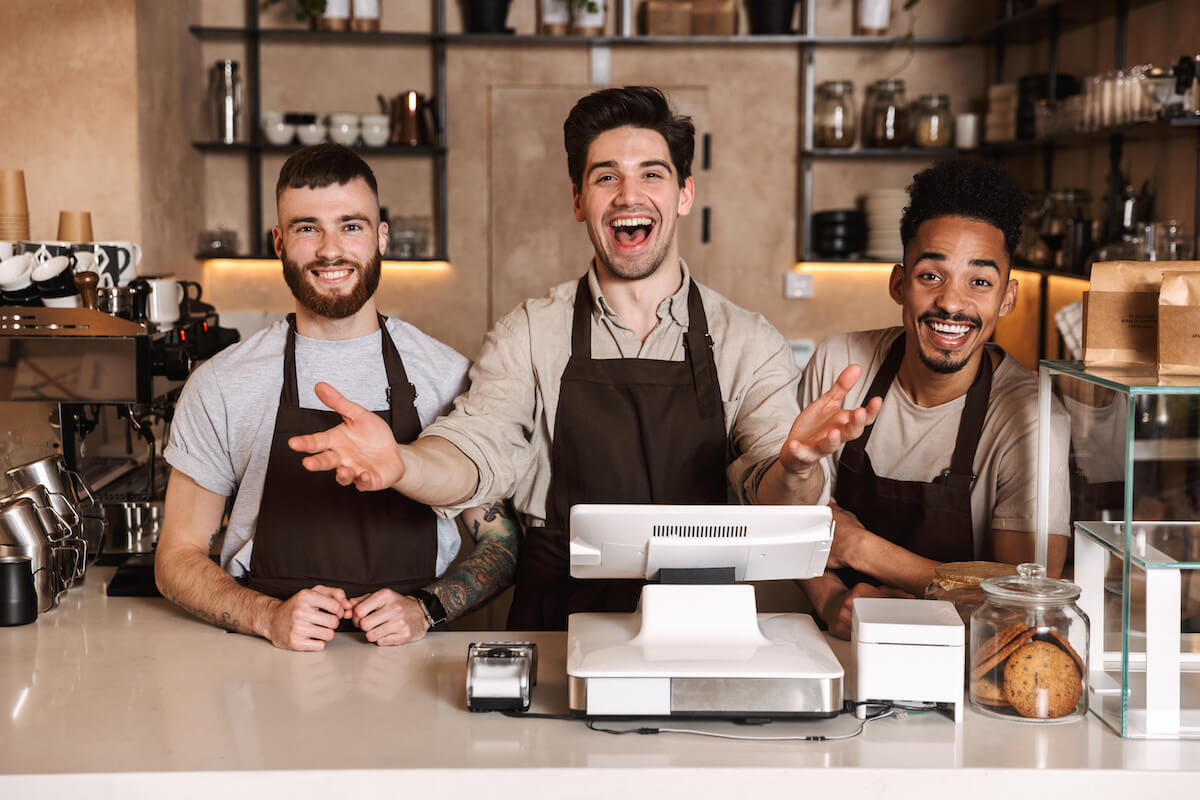Hospitality Everywhere: Understand the keys to restaurant digital marketing success
Skip the article and turn takeaways into action by scheduling a call with our team.
Today, businesses of all varieties operate in a digital landscape—and the horizon keeps expanding. Restaurants must adapt to this reality and realign their practices to not only stay afloat but to ride the wave for continued success.
Key performance indicators, or KPIs, are metrics that gauge how you’re doing in this ever-changing digital world. Knowing what restaurant KPIs to measure is now an essential part of the job for restaurant owners and restaurant managers. They provide a roadmap for improving performance and operations.
Of course, there’s always a bit of a learning curve involved. But the effort you put into building, measuring, and optimizing your restaurant’s digital presence can pay big dividends toward your success.
Yelp for Restaurants’ software suite is a powerful tool that can give you a serious advantage. It bridges the gap between the human side of the restaurant industry and the number-crunching nitty-gritty of running a business.
There are many ways to build and power your digital hospitality presence and just as many metrics to steer your success. This guide will examine various digital channels and the KPIs you should use to know you’re on the right track. Let’s get started by discussing why you need a digital brand presence in the first place.
The importance of a digital brand presence

Today’s diners make more informed restaurant choices than ever before. Gone are the days of ordering from a pile of menus on the kitchen counter. Some 97% of Americans now have smartphones or tablets. When hunger or thirst sets in, consumers reach for their smart devices and search for what they’re craving. After all, how cool is it that we can push a few buttons and find out all about restaurants or have their food show up at our doorstep?
That’s why building brand awareness online in as many spaces as possible is one of the most important things you can do to attract both new and returning customers.
Note the “as many spaces as possible” part. The internet is a diverse place, with people relying on search engines, social media, and more to get what they want. This means you should look to build brand awareness on:
- Search engines like Google and Yelp
- Your website
- Social media platforms like Facebook, Instagram, TikTok, Twitter, and Yelp Connect
- Third-party apps like UberEats and DoorDash
To convert online searchers into customers, you need to expand and optimize your online presence in each of these areas. And make sure you’re getting the most out of your digital marketing channels by measuring the right restaurant KPIs.
KPI to remember: Customer engagement
Tracking customer engagement (views, likes, comments, or clicks) across all platforms over a set period of time can give you an idea of how your overall digital performance is trending. But dig deeper than just the total number of viewers or followers. See how these trends map to your total sales and total revenue:
- If engagement is increasing as well as sales and number of customers, then great! Your online content is compelling and brings diners in-house.
- You’ll need to reevaluate your digital strategy if engagement increases but not sales. The content might be interesting enough to get likes, but you’re not creating a sense of community or loyalty–or incentive! Think how you can convince viewers to get offline and come enjoy your food.
- If engagement is static and sales are dropping, you may want to see if your online content has any negative reviews or impact. Or maybe it’s time to look beyond your online content and adjust your total marketing strategy altogether.
How to boost your brand online

Before you can track engagement, you need to grow your digital hospitality presence. The key to successful growth lies in digital marketing. Those two words cover a lot of territory in the restaurant industry. But, by online building brand awareness, strong digital marketing can attract diners at the local level. Here are three key elements of your online brand.
1. Claiming and developing online business pages
Claiming your online business pages is a simple but powerful step to improving your digital footprint. And as a restaurant, you need to be sure to verify your business on both Google and Yelp. People turn to these two platforms by the millions each day to search for information and find a place to eat—make sure they can find you!
Verifying your restaurant is relatively quick and painless. But take the opportunity to flesh out what makes your business unique. Go beyond the basics to stand out: Include your restaurant’s history, a meet-the-owner section, specials and specialties, and more.
To grow your following online, maintain consistency across the platforms. That means including similar photos, the same contact info, hours, menus, and announcements.
Photos are crucial in developing your business profiles—don’t skip this step! Yelp Business pages with 10 or more photos see 12 times more customers per month than those with fewer photos.
KPI to remember: Analytic insights
Both Yelp and Google provide reporting features to track the performance of your online business profiles. Get data on how many views your pages get, what search terms people use, and how and why people engage with your page. Then use these insights to craft better-targeted content online and better services in-house.
2. Managing community and reviews
Once you have business pages and other digital channels, you provide a forum for customers to discuss your restaurant. Online reviews and customer feedback are a significant part of the restaurant world these days. They can have a big impact on the success of your establishment.
Whether the reviews are positive or negative, responding to them and managing your online community is vital. Taking the time to acknowledge the review will improve your image, remind customers that you’re a real human being, and add personality to your establishment.
Responding to positive reviews is straightforward:
- Thank the customer for their review
- Address any specific comments they may have, including crediting staff for a job well done
- Tell the customer you look forward to serving them again
- Pass on the praise to your staff for a well-deserved morale boost
Negative reviews may be challenging at first, but they can provide valuable feedback for areas to improve. Like with positive reviews, you can follow a few steps:
- Thank the customer for their review
- Address and acknowledge their specific complaint, if there is one
- Discuss ways you plan to improve the problem area in the future and offer your contact info to the commenter
- Pass on the comment to the staff, so they are aware of the issue at hand
Internet trolls are an unfortunate reality, but their invalid complaints can be flagged, and you may get them removed. Whatever the case, keep a cool head and respond with gentle humor to diffuse their effect.
KPI to remember: Qualitative comments
Use the comments and reviews you get—all of them, both good and bad—to get anecdotal evidence of your online brand presence and the food you serve. Particularly good reviews can get repurposed into social media posts and testimonials too.
3. Building and maintaining social media profiles
Responding to reviews is a reactive way to add to your brand’s personality and voice. But, creating your social media presence is a proactive way that you control from the get-go.
Using social media to drive business to your restaurant is a must these days. And an engaging presence on the most widely used platforms, like Yelp Connect, Facebook, Instagram, Twitter, and TikTok, sets the foundation for all of your digital channels.
The most important thing you can do to strengthen your social media presence and attract social media users is to post regularly. Aim for at least one social media post a week per platform to maintain and build your restaurant brand.
Teaming up with local influencers can boost your online brand awareness too. As many as 49% of consumers rely on influencers for tips about new restaurants, so creating solid relationships can work in your favor.
KPI to remember: Aggregated analytics
Each social media platform has dashboards to measure KPIs. To save time, use a social media scheduling tool. You can post to many platforms at once and get the same platform-specific analytics and trends with the added advantage of gauging overall performance across all platforms.
How to stand out in search results

In 2020, there were over a billion searches for restaurants on Google. Searches for “restaurants near me” continue to be one of the fastest-growing search terms. While Google currently has an 85% share of the global search engine market, diners also rely heavily on social media to find a place to eat.
Standing out in search results can have significant business benefits. Building a website—even a simple one—can significantly improve your odds of showing up high in search results. What’s more, it gives you a platform to promote your page with content that’s search engine optimization (SEO) friendly.
There are two primary methods of improving your standing in search and social media—and there’s a third using Yelp. We’ll start with paid advertisements, then discuss SEO, and then Yelp Advertising.
1. Search engine marketing: Paid advertisements in search and social
Search engines and social media platforms offer paid advertising for restaurants. The idea behind search engine marketing (SEM) is that you pay to show up at the top of the search results page for relevant search terms. Paid ads work best when you want to generate traffic or sales immediately, like advertising a promotion, menu special, or event in your space.
You can easily set up a Google Ads account to manage pay-per-click (PPC) and YouTube ads from one dashboard. The learning curve after that becomes steeper, though. To reap the benefits of SEM on Google, you need to spend the time to understand and manage the process for maximum return on investment.
When advertising on social media, each platform will have a paid-ad service–like Facebook Ads–that you access from your admin hub. Remember to keep the message simple and memorable. Include a photo, a special you’re advertising, or a thumbnail of an event invitation. Most people don’t spend long looking at advertisements, so get to the point to get the click!
There are no guarantees with search engine marketing. Deciding to advertise comes down to your available budget, the size of your potential audience, and the time you can dedicate to managing and optimizing your campaigns.
KPIs to remember: Campaign metrics
SEM is tricky because you can lose your advertising dollars if you don’t watch your campaign performance. You need to refine campaigns to make sure you zero in on the right audience. Track important campaign metrics like click-through rate (CTR), conversion rate, and cost per click (CPC).
With search, pay attention to your keywords and ad copy, too, like which keywords get the most clicks and which ads convert actual customers.
On social media, aim for engagement levels of around 1-5%. Keep note of what posts perform the best and try to make a reusable formula out of them.
2. SEO and organic search
SEO focuses on optimizing the content of your website to rank higher in search results. With success, you’ll drive more organic traffic to your website–and hopefully to your restaurant!
Landing on the coveted first page of the Google SERP can help you bypass any need for paid ads. But, SEO is a long game that requires a fair amount of marketing-industry know-how.
Fear not; even a little effort can yield some results. When creating content for your website, imagine what search terms people use and write copy that fulfills that search intent.
Effective SEO underscores why it’s important to have as much information about your business as possible online. If someone searches for “Thai restaurants Cincinnati” and you run a Thai restaurant in Cincinnati, good SEO ensures you appear on Google.
KPI to remember: SERP ranking and presence
Pay attention to where you land on SERPs for different search terms that pertain to your restaurant and cuisine. If you don’t show up in a search until the third page of the search results, you may want to rethink your SEO strategy.
Just to reiterate—you can get in the weeds working on SEO, and you already have a restaurant to run. If you have the budget for it, consider hiring an SEO agency or a freelancer specializing in localized SEO.
3. Yelp Ads
76 million consumers visit Yelp each month. If you’re thinking, “Wow, that’s a lot,” well, you’re right. Tap into this already-built customer base with Yelp Ads. As with SEM, you can use keyword and area targeting to make sure your marketing is getting in front of the perfect audience.
Combining Yelp Ads with Yelp Connect makes for a powerful…combination. With a community of followers on Yelp Connect, using the two tools together makes for a lucrative payoff without firing off advertising shots into the dark.
Yelp’s Upgrade Package helps reach even more customers on the platform. Your posts will be promoted in the Yelp App and via weekly emails sent to local customers. Plus, restaurateurs can block competitor ads from appearing on their page to ensure diners pick your restaurant.
KPIs to remember: Yelp Ads Dashboard
As with other platforms, turn to the Yelp Ads Dashboard to understand how your ads perform. You can track campaign success with familiar metrics like CTR and CPC, and visual indicators like an impression heatmap. Get insights into how you can better understand the volume and types of leads you could get with the Lead Visualization tool.
How to convert searchers into guests and guests into loyal customers

A number of tools exist to help get customers in the door—and keep them coming back. Many of these tools come conveniently packaged and ready to use with Yelp for Restaurants.
Stand out to diners searching online with Yelp for Restaurants, which harnesses the power of Yelp’s network, Yelp Ads, and Yelp Guest Manager. Four key aspects of this service will instantly improve your customers’ online experience of your brand.
1. Online waitlists
The waitlist feature in Yelp Guest Manager is one of the most powerful tools restaurants can use to help encourage customers to show up. Rather than wasting time waiting in line in person, customers can check wait times provided by the Yelp app from anywhere.
Diners can wait wherever they want and get a text notification when their wait time is about up and their table is ready. Two-way text messaging between the restaurant and the customer ensures clear communication.
2. Online reservations
Customers can also book restaurant reservations via the Yelp app to avoid messy and potentially confusing phone calls. The convenience of an online system improves your digital presence. The app allows customers to book their desired time, group size, and more.
The online system has its advantages in-house too. Because the reservation is booked directly into Guest Manager, staff will be able to know what to expect and when—and prevent any overbookings.
3. Unique calls to action
Your call to action (CTA) is the next step you want your online followers to take that will convert a potential customer into an actual customer. That’s the button or link on your Yelp Business Page, for example, that leads a person to book a reservation, get on a waitlist, or order delivery or takeout.
Yelp Connect takes CTAs to the next level. Create posts, share photos, and let diners know what’s happening at your restaurant. Then customize your CTA so followers can “Make a Reservation” or “Book a Table” directly from your posts.
4. Multiple online entry points to your restaurant
The more places customers see a call to action for your restaurant, the better. An advantage of Guest Manager is that diners have several entry points to discover your restaurant online.
Many diners start their search for a new restaurant on Yelp. Assuming you have Guest Manager, customers can book a reservation or get on your waitlist via the Yelp App. Or customers can do those same things via your website thanks to Yelp widgets that link directly to your Guest Manager.
How to streamline operations, improve ROI, and reduce costs
 Another facet of digital hospitality is how technology can impact restaurant operations. Yelp Guest Manager doesn’t just improve your customers’ online experience of you. It provides powerful tools to streamline workflows, especially in your front-of-house (FOH).
Another facet of digital hospitality is how technology can impact restaurant operations. Yelp Guest Manager doesn’t just improve your customers’ online experience of you. It provides powerful tools to streamline workflows, especially in your front-of-house (FOH).
When you’re working full tilt, and your FOH is slammed, you know how one hiccup can throw off an entire day. That means you need software that’s both intuitive and reliable. And you need a heavyweight with analytics so you can hone in on successes and problems.
Yelp Guest Manager
Yelp Guest Manager is an all-in-one FOH system. For example, you can optimize your table and seating flow. Assign table statuses to track where guests are within a meal and improve decision-making about expected incoming table flow, server assignments, and more.
Guest Manager also provides robust analytics assigned to each guest. Servers can know their favorite dish or cocktail and when their birthday is, for example. This can dramatically boost customer satisfaction and make any number of guests wonder just how you have such a good memory.
Guest Manager integrates with several different point of sale (POS) systems, many of which integrate with other valuable software like inventory management tools. When your POS system and Guest Manager work together, you can determine what menu offerings work, which ones don’t, and which are most profitable.
Yelp Kiosk
Yelp Kiosk is a hardware and software combination that effectively reduces FOH busywork by 50%—specifically, that of the host. It allows guests to check in and seat themselves, removing the necessity of assigning staff to these tasks.
A self-serve host system is especially valuable during the current labor shortage. One extra server on the floor can mean the difference between being swamped and keeping things flowing smoothly.
Restaurant KPIs to remember
Yelp Guest Manager defines some of the most important restaurant KPIs that clarify how your business is performing. Teamed with a good POS and inventory management system, Guest Manager can help determine:
- Cost of goods sold (COGS)
- Food cost percentage
- Revenue per available seat hour (RevPASH)
- Table turn time
- Employee turnover rate and labor costs
- Your most and least profitable menu items
- Prime cost (overall labor cost + COGS)
- Customer retention rate
- Gross profit, net profit and estimated profit margin
- Your break-even point
The ultimate KPI: Increasing customer lifetime value

Having one customer come in is great. Having the same customer come in many times is even better. Gaining a customer’s loyalty increases their customer lifetime value (CLV). But how can you ensure they’ll return consistently–hopefully with friends and family? A restaurant’s average CLV is one of the most important metrics to track and closely ties to a restaurant’s profitability.
If you want to make sure that this ultimate restaurant key performance indicator is continually trending up, here are four tactics you can try.
1. Customized guest experiences
Yelp Guest Manager is a powerful ally in creating that personal touch for your diners, online and in-house. Guest Manager keeps track of a significant amount of customer data, including preferences.
With just a few keystrokes, servers can easily access intel on a returning diner and create a customized guest experience. Got a regular customer on a date? Make them look good by remembering their name and comping a drink or dessert. The same can be said of someone who comes in with a case of the blues—being recognized and appreciated can help turn someone’s day around.
People respond to this excellent customer service. This combination of powerful software and the human touch is a cornerstone in increasing your average CLV.
2. Targeted email marketing campaigns
Communicating with regulars keeps your restaurant top of mind. The effort invested in a well-crafted email campaign is often time and money well spent. For each dollar spent on such a campaign, small business owners can expect an average of $36 in returns.
Emails sent to customers should be short, sweet, and to the point. This is where special offers can really shine—they’re the perfect opportunity to send an email blast out to remind customers to come to your venue. And customers returning to your venue is exactly how you increase CLV.
Add an option to sign up for an email list when you provide their check via a QR code. Display the same QR code on a poster, window sticker, or table tent. Customers can also sign up for your email list on your website.
3. Loyalty programs
If you want loyal customers for years to come, a restaurant loyalty program has rewarding their devotion baked in! And to make things easier for you and your guest, the current trend is toward digital loyalty programs.
That said, customer rewards programs can vary widely, but a few examples include:
- A loyalty card/phone number system: Customers keep the card or give their phone number and receive a particular reward.
- A mobile app: Mobile apps require a bit more work and cost but can be very effective, especially for larger or chain restaurants with deeper pockets.
- An email/social media program: Email and social media campaigns need to state clearly and quickly what customers get out of the deal since it’s very easy to ignore or scroll past notifications.
- Yelp check-ins: This concept is quite simple: Someone checks in on Yelp, and they get something like a free drink. Restaurants can customize what offers customers receive, which can change on any given day.
A good rewards program can increase CLV as long as it is:
- Simple enough for anyone to understand
- Respectful of customers’ information
- Fun, unique, exciting, and rewarding enough to be meaningful
Rewards programs can and should vary greatly from restaurant to restaurant. But if you keep these three principles in mind, you should foster loyalty among your fans.
4. Creating community with customers
With a robust social media and web presence, you will find it easier to build a sense of community around your restaurant. This must happen across all your socials since different customers prefer different platforms.
A good rule of thumb is to communicate with guests on any marketing channel—social media, email, and more—around once a week. Your website doesn’t need to be updated that often, but the fresher it is, the more customers will be able to rely on it. Monitoring your profiles, providing engaging and consistent content, and interacting regularly is the recipe for building your community of repeat customers and brand advocates.
Yelp for Restaurants for the digital marketing win

Anyone who runs a restaurant knows how many moving parts there are to keep track of. That’s as true for a food truck or pop-up restaurant as a full-blown Las Vegas casino venue. From knives to walk-in fridges and everything in between, the equipment a restaurant uses makes a huge difference in its success. Software is just another tool in a modern restaurant, and there’s no reason to settle for anything but the best.
Using Yelp for Restaurants allows restaurateurs to tap into the true potential of restaurant tech. It’s a game changer that gets the ball rolling—and rolling in the right direction.
With Yelp for Restaurants, you can boost your digital brand presence, attract diners at the local level, stand out from competitors, convert searchers into guests and guests into repeat customers, streamline restaurant operations, and increase customer lifetime value.
That’s a heck of a value, we think. We’d love for you to think so as well.
If you think Yelp for Restaurants sounds right for you, reach out to us for a free demo and to speak to one of our restaurant tech experts. Once you’re on board, you’ll have a powerful ally on your side to help make your restaurant–both online and in person–the best it can be.